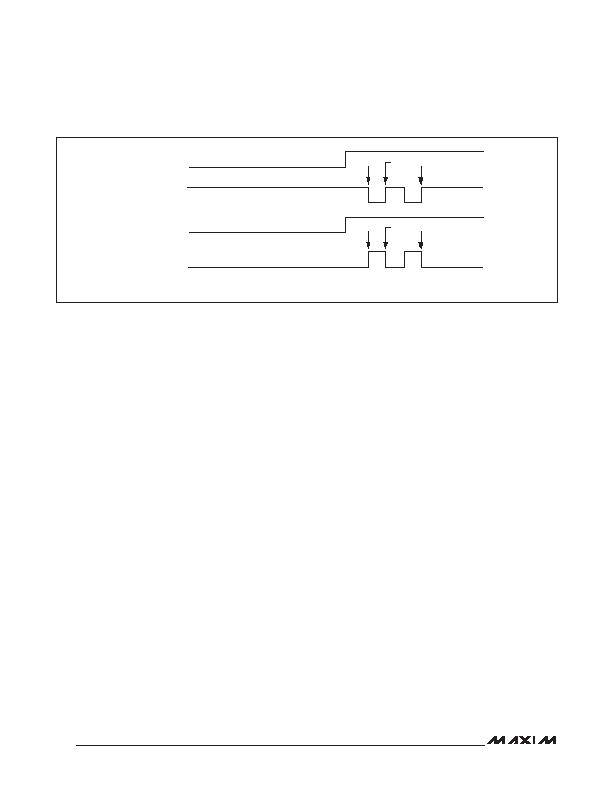
Digital Thermometers and Thermostats
with SPI/3-Wire Interface
12
Figure 7. Serial Clock as a Function of Microcontroller Clock Polarity (CPOL)
Address and Data Bytes
Address and data bytes are shifted MSB first into the
serial-data input (SDI) and out of the serial-data output
(SDO). Any transfer requires the address of the byte to
specify a write or a read, followed by one or more bytes of
data. Data is transferred out of the SDO for a read opera-
tion and into the SDI for a write operation. The address
byte is always the first byte entered after CE is driven
high. The MSB (A7) of this byte determines if a read or
write takes place. If A7 is 0, one or more read cycles
occur. If A7 is 1, one or more write cycles occur.
Data transfers can occur 1 byte at a time in multiple-byte
burst mode. After CE is driven high, an address is writ-
ten to the devices. After the address, one or more data
bytes can be written or read. For a single-byte transfer,
1 byte is read or written and then CE is driven low (see
Figures 8 and 9). For a multiple-byte transfer, however,
multiple bytes can be read or written to the devices
after the address has been written (see Figure 10). A
single-byte burst read/write sequentially points through
all memory locations and loops from 7Fh/FFh to 00h/80h.
Invalid memory addresses report an FFh value.
3-Wire Serial-Data Bus
The 3-wire communication mode operates similarly to
the SPI mode. However, in 3-wire mode, there is one
bidirectional I/O instead of separate data-in and data-
out signals. The 3-wire consists of the I/O (SDI and
SDO pins connected together), CE, and SCLK pins. In
3-wire mode, each byte is shifted in LSB first, unlike SPI
mode where each byte is shifted in MSB first. As is the
case with the SPI mode, an address byte is written to
the devices followed by a single data byte or multiple
data bytes. Figure 11 illustrates a read and write cycle.
Figure 12 illustrates a multiple-byte burst transfer. In
3-wire mode, data is input on the rising edge of SCLK
and output on the falling edge of SCLK.
CE
SHIFT
SHIFT
INTERNAL STROBE
INTERNAL STROBE
CPOL = 1
CPOL = 0
SCLK
CE
SCLK
NOTE: CPOL IS A BIT THAT IS SET IN THE MICROCONTROLLERS CONTROL REGISTER.
发布紧急采购,3分钟左右您将得到回复。
相关PDF资料
MAX31826MUA+T
IC TEMP SENSOR DIGITAL 8UMAX
MAX4006EUT+T
IC CURRENT MONITOR 1% SOT23-6
MAX4008EUT+T
IC CURRENT MONITOR 1% SOT23-6
MAX4370ESA+T
IC CNTRLR HOT-SWAP 8-SOIC
MAX4995AFAVB+
IC CURRENT SWITCH 10% 10UTQFN
MAX5900AAEUT+T
IC HOT-SWAP CONTROLLER SOT23-6
MAX5903LAETT+T
IC HOT-SWAP CONTROLLER 6-TDFN
MAX5909EEE+
IC HOT-SWAP CTRLR DUAL 16QSOP
相关代理商/技术参数
MAX31723MUA+T
功能描述:板上安装温度传感器 SPI/3-Wire Digital Temp Sensor RoHS:否 制造商:Omron Electronics 输出类型:Digital 配置: 准确性:+/- 1.5 C, +/- 3 C 温度阈值: 数字输出 - 总线接口:2-Wire, I2C, SMBus 电源电压-最大:5.5 V 电源电压-最小:4.5 V 最大工作温度:+ 50 C 最小工作温度:0 C 关闭: 安装风格: 封装 / 箱体: 设备功能:Temperature and Humidity Sensor
MAX31723PMB1#
功能描述:温度传感器开发工具 MAX31723 Peripheral Module
RoHS:否 制造商:Texas Instruments 产品类型:Temperature Sensors and Control ICs 工具用于评估:MSP430G2553 接口类型:USB 工作电源电压: 工作电源电流:
MAX31725MTA+
功能描述:板上安装温度传感器 .5+- DEG C I2C RoHS:否 制造商:Omron Electronics 输出类型:Digital 配置: 准确性:+/- 1.5 C, +/- 3 C 温度阈值: 数字输出 - 总线接口:2-Wire, I2C, SMBus 电源电压-最大:5.5 V 电源电压-最小:4.5 V 最大工作温度:+ 50 C 最小工作温度:0 C 关闭: 安装风格: 封装 / 箱体: 设备功能:Temperature and Humidity Sensor
MAX31725MTA+T
功能描述:板上安装温度传感器 .5+- DEG C I2C RoHS:否 制造商:Omron Electronics 输出类型:Digital 配置: 准确性:+/- 1.5 C, +/- 3 C 温度阈值: 数字输出 - 总线接口:2-Wire, I2C, SMBus 电源电压-最大:5.5 V 电源电压-最小:4.5 V 最大工作温度:+ 50 C 最小工作温度:0 C 关闭: 安装风格: 封装 / 箱体: 设备功能:Temperature and Humidity Sensor
MAX31726MTA+
制造商:Maxim Integrated Products 功能描述:+/-0.5C I2C TEMP W/RESET - Rail/Tube
MAX31726MTA+T
制造商:Maxim Integrated Products 功能描述:+/-0.5C I2C TEMP W/RESET - Tape and Reel
MAX3172CAI
功能描述:RS-232接口集成电路 RoHS:否 制造商:Exar 数据速率:52 Mbps 工作电源电压:5 V 电源电流:300 mA 工作温度范围:- 40 C to + 85 C 安装风格:SMD/SMT 封装 / 箱体:LQFP-100 封装:
MAX3172CAI+
功能描述:接口 - 专用 3.3V 3Tx/3Rx Tcvr Multiprotocol RoHS:否 制造商:Texas Instruments 产品类型:1080p60 Image Sensor Receiver 工作电源电压:1.8 V 电源电流:89 mA 最大功率耗散: 最大工作温度:+ 85 C 安装风格:SMD/SMT 封装 / 箱体:BGA-59